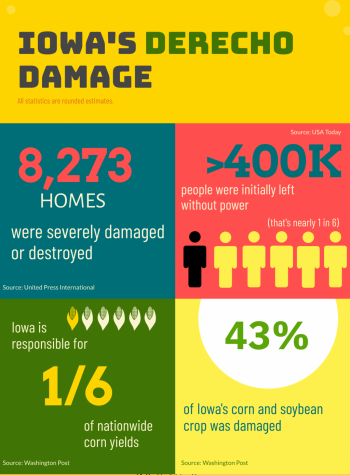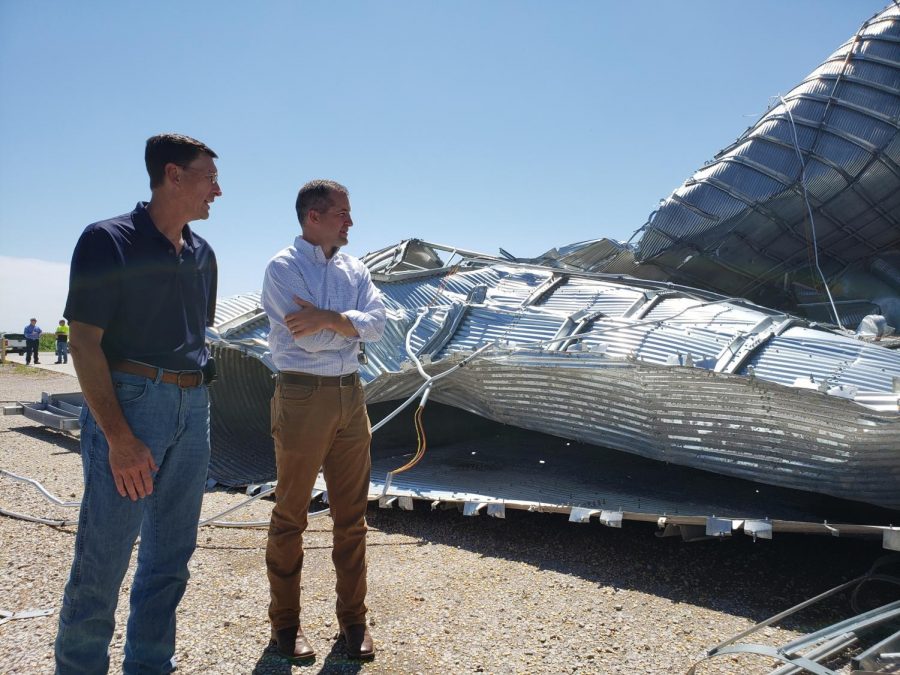Disastrous derecho: Iowa’s unexpected storm
A surprise derecho blew through Iowa on Aug. 10, leaving behind local and statewide damage.
Nearly 8,300 homes were damaged in a matter of minutes. A gloomy Monday morning in Iowa turned into a disastrous storm with wind speeds reaching 140 mph, equivalent to a major hurricane. This storm was classified as a derecho, devastating 43% of corn and soybean crops and leaving upwards of $82.7 million in property damage.
The effects of the Aug. 10 derecho reached a large number of Iowans, including many in the West High community. Grace Paxton ’22 and her family lost power for four days, with plenty of others being in similar boats.
“The first night we had tried to find a hotel so we could use power, but all of them were either also without power or full,” Paxton said.
Like Paxton, over 400,000 were initially left powerless and around 30,000 are still without it, as of Aug. 20. Although Paxton’s family lost just a few roof shingles in terms of property damage, they noticed many knocked-down street signs and uprooted trees. Governor Kim Reynolds estimated that 8,273 homes were destroyed or experienced major damage, and Alliant Energy identified over 2,500 destroyed utility poles, according to United Press International.
The Cedar Rapids (CRCSD) and Linn-Mar Community School Districts have both delayed their school start dates, with every building in the CRCSD being damaged. Recognizing the unfortunate effects of the derecho, many communities in the state have come together in cleanup efforts, food donations and other disaster relief initiatives.
“Almost immediately after the storm ended, many of my neighbors gathered to clean up the street and yards that were covered in sticks as well as larger branches, including two neighbors using chainsaws to remove what looked like it could’ve been a small tree,” Paxton said.
Furthermore, grocery stores and churches are among those engaged in food distribution, and Operation BBQ in Cedar Rapids has been serving around 1,000 hot meals daily.

On the federal level, President Trump signed the disaster declaration requested by Gov. Reynolds on Monday and visited Cedar Rapids on Tuesday to survey the damage. The governor called for nearly $4 billion in federal aid, writing, “Resilience is in our DNA, but we’re going to need a strong and timely federal response to support recovery efforts.”
Much of the federal aid will go towards helping the agriculture industry which has suffered the most significantly. According to The Washington Post, around 43% or 10 million acres of Iowa’s corn and soybean crop has suffered damage from the derecho, leaving a $10 billion dent in the industry that is crucial to the state’s economy.
Iowa has been the country’s top corn producer for 26 years, with 2.58 billion bushels harvested last year, accounting for about one-sixth of nationwide yields.
Beginning in 2013, however, the agricultural industry has been hit repeatedly. This year’s trade disputes, ethanol industry decline, low demand and global pandemic all contribute to the lowest corn prices in over a decade.
The agricultural community is still recovering from the economic challenges caused by COVID-19, and the derecho represents yet another setback.
“These farmers put significant resources into this crop and were planning for strong yields. Now their crops have been damaged—some destroyed—and the state has lost tens of millions of bushels of grain storage just a few weeks before harvest begins,” said Iowa Secretary of Agriculture Mike Naig.
Not only will farmers struggle with production and sales, but they also may lack sufficient storage for their crops. According to the Iowa Department of Agriculture and Land Stewardship, the derecho seriously damaged or destroyed more than 57 million bushels of commercial grain storage capacity.
Iowans have been blown away by the effects of the derecho.
“In the short term, many of our farmers and businesses still need help cleaning up from the storm. Some are without power and need generators to turn on their lights, run their equipment and feed their livestock,” Naig said. “Looking down the road, we’ll also need support from our neighbors, crop insurance companies and federal disaster aid.”
To support farmers in the future, Iowans can make an effort to purchase Iowa-grown produce that they still have available.
For Paxton, the storm’s magnitude came as a surprise and the road to recovery seems indeterminate.
“I honestly thought this would be a normal thunderstorm, but the winds picked up so fast,” Paxton said. “I am scared to think about how long it will take for eastern Iowa to fully recover.”
Your donation will support the student journalists of West High School. Your contribution will allow us to purchase Scholarship Yearbooks, newsroom equipment and cover our annual website hosting costs.

(she/her) Maya is a senior and this is her third year on staff. She is the feature editor for print and is super excited for another great year. She loves...

(she/her) Krisha Kapoor is a Senior at West High. This is her third year on staff, and she is the Print Co-Editor-In-Chief. Outside of the newsroom, you...




